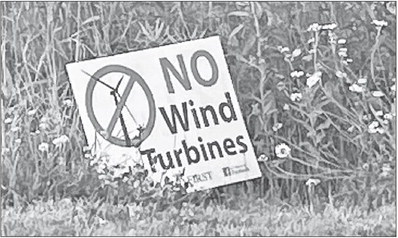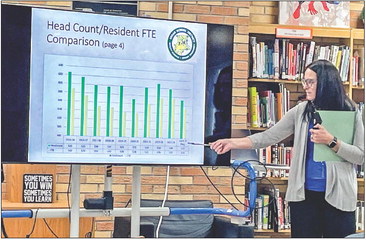Wind council divided over health issues


By Kevin O’Brien
A recent report by Wisconsin’s Wind Siting Council perfectly illustrates the stark divide over the issue of wind energy and public health that has engulfed Central Wisconsin.
On one hand, after reviewing 59 peer-reviewed studies, a majority of the council’s 15 members came to the conclusion that the latest research “did not produce new evidence of direct adverse health effects from wind energy systems.”
“If anything, recent research has identified numerous health benefits that result from replacing fossil fuel power plants with emissionfree wind energy,” the report states.
Based on its research, the Wind Siting Council (WSC) sees no need for “a substantial revision to wind siting policies in Wisconsin.”
“Current wind siting and permitting processes are intended to balance human health and community concerns with a stable and consistently applied regulatory framework,” the report states.
However, a “minority report” issued by four members of the council recommends an immediate moratorium on wind energy systems (WES) in Wisconsin “until on-site, unbiased research can be completed to form the basis for any new legislation to regulate WES.”
“The inadequate wind turbine siting regulations and increasing harm being done to more residents requires this action,” the minority report states.
The authors of the minority report – which included a realtor, a town official from Brown County and a landowner living next to a wind farm – said their objective is to tell “the whole story” about the unique dangers posed by wind energy production.
“Without the whole story and new changes to the statute, the international wind companies and their stockholders will continue to find it easy in Wisconsin to reap massive benefits of billions of dollars at the expense of the health, home, community, and life investments of Wisconsin residents,” the report states. “Such a situation is inevitable when those who make the decisions reap rewards while others pay any and all costs associated with the decision.”
Under state law, the WSC is responsible for researching the effects of wind turbines on public health and providing advice to the Public Service Commission (PSC), which sets the regulations for all wind projects that produce 100 megawatts of power or more. The law requires the WSC to submit an updated report to the state legislature every five years; one was due in 2019, but it was delayed until this year.
Members include energy company representatives, landowners, environmental activists and a University of Wisconsin professor.
The report released in May says it is “reasonable to conclude that most individuals living near wind energy systems do not experience detectable health effects directly caused by the wind turbines,” based on the “literature that was accepted by the council for inclusion in the report.”
Out of the 59 research articles referenced in the report, “only three studies suggested potential negative health impacts from wind turbines.” “However, after a thorough review of these studies, reasonable arguments were found to question the legitimacy of their conclusions.”
The report’s executive summary also noted that seven of the 59 studies indicated “significant positive health benefits” from wind turbines, and 12 identified “annoyance” as the primary effect of wind turbines on people living near them.
Still, WSC members who signed on to the minority report said “annoyance” is not something to be dismissed, as it can lead to sleep disturbances, chronic stress and feelings of hopelessness.
The minority report accused the rest of the WSC of downplaying the negative impacts of wind turbines, especially when it comes to infrasonic (low frequency) air pressure pulses created by the spinning of the blades.
“Residents near turbines are experiencing a wide range of symptoms: loss of sleep, headache, migraine, vertigo, balance issues, brain fog, sinus pain and ear pressure are common,” the minority report states.
The main report goes through a list of issues related to wind turbines, such as noise, shadow flicker and signal interference, but it repeatedly points out that studies from the United States, Canada and Europe have shown little or no adverse health impacts. Instead, one section of the report suggests that many health complaints are linked to people’s preconceived notions of wind turbines, which may be “primed” by negative media coverage or fears of property devaluation.
A few studies also looked at the factors that lead to local communities enacting wind siting regulations, including one study that involved over 1,600 counties in 23 states.
“The study finds that when county governments have more interactions with wind developers, they are more likely to take formalized action to regulate wind projects in their area,” the study states. “They are not necessarily more likely to enact stringent regulations.”
The question of local control versus state jurisdiction has been a contentious one in Central Wisconsin, with many rural residents demanding greater authority over wind and solar operations. One paragraph in the WSC report notes that 19 states have no state-level regulations for wind farms, and another six offer only recommendations “These states largely leave wind energy system siting to local jurisdictions,” the report states.
To see the full report, search for “2024 Wind Siting Report,” which is available on the PSC’s website.
SIGN OF THE TIMES - Signs expressing opposition to industrial wind turbines can be seen on properties throughout Marathon and Clark counties. STAFF PHOTO/KEVIN O’BRIEN




